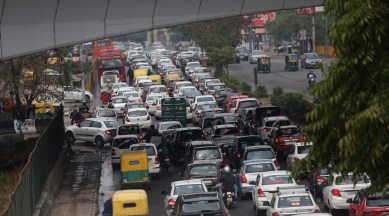Stay updated with the latest - Click here to follow us on Instagram
To check surging ozone levels, experts suggest tackling traffic in capital
Over the past week, the Central Pollution Control Board (CPCB) has identified ozone as a prominent pollutant in Delhi on June 2 and June 6.

Controlling vehicular pollution could be key to reducing the surge in ozone levels in the city that comes with the rise in temperature, experts say.
Over the past week, the Central Pollution Control Board (CPCB) has identified ozone as a prominent pollutant in Delhi on June 2 and June 6.
monthly limit of free stories.
with an Express account.
Data from the Delhi Pollution Control Committee (DPCC) for May also indicates that ozone levels were well above the 8-hour standard of 100 µg/m3 and hourly standard of 180 µg/m3 according to the National Ambient Air Quality Standards at different monitoring stations on multiple days. At 12 pm on May 20 at Anand Vihar, for instance, the ozone level was as high as 309.8 µg/m3, while it was around 235.9 µg/m3 at the Jawaharlal Nehru Stadium on May 19 at 1 pm. It was even higher at Anand Vihar at 7 pm on May 18, at 345.7 µg/m3.
A recent analysis by the Centre for Science and Environment (CSE) noted that spatial spread of ozone in Delhi-NCR began in March this year with early heatwaves. The analysis had stated that the geographical spread of ground-level ozone pollution in NCR in March and April this year was the highest in the past four years, with around 16 stations exceeding the standard daily over the two months.
“Ozone is a secondary pollutant. It forms due to atmospheric reaction among nitrogen oxides and VOCs (volatile organic compounds) in the presence of sunlight. Nitrogen oxides that are emitted from vehicles are there in the atmosphere. VOCs are also present because of unburnt hydrocarbons. The VOCs energise nitrogen oxides in presence of sunlight to convert into ozone,” said Dipankar Saha, former additional director, CPCB, and former head of air quality monitoring division in Delhi.
Sunlight and high temperatures in summer contribute to increase in ozone formation. “Reducing VOCs is important… VOCs can be controlled through better fuel efficiency,” Saha said.
Anumita Roychowdhury, executive director, research and advocacy, CSE, said, “Ozone is not directly emitted from any source. The gases that come from vehicles, industries, power plants… particularly nitrogen oxides and VOCs, under the influence of sunlight and temperature react to form ozone. To control ozone, we need to control precursor gases… Nitrogen oxide acts as catalyst and vehicles contribute the maximum to nitrogen oxide emissions. In case of Delhi, vehicular pollution is a challenge. Air pollution control and mitigation now is focused on particulate pollution coming from combustion and dust, but for ozone formation, gases are solely responsible.”
Ozone is known to be a harmful gas for those who have respiratory conditions since it is highly reactive, Roychowdhury said. “Even if it increases for a short period, it can have a trigger effect on vulnerable people,” she added.
Meanwhile, the Commission for Air Quality Management (CAQM) has invited “research and development proposals” and “pilot projects for field demonstrations” for “improvement of air quality”. The CAQM will provide financial support for the proposed projects which are to be completed within a maximum period of two years.